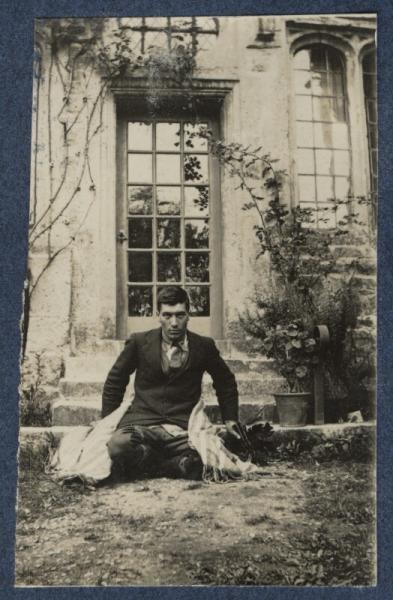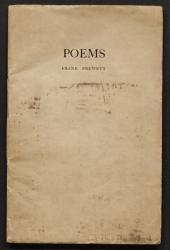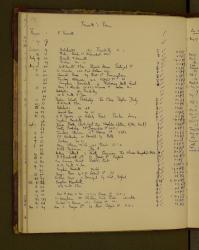Frank Prewett
Frank Prewett
Born:
Mount Forest, ON, Canada
Died:
Inverness, United Kingdom
Occupation:
Biography
Authored By: Sara Barnard
Edited By: N/A
Canadian war poet Frank James Prewett (nicknamed “Toronto”) was born August 24, 1893 near Mt. Forest, Ontario on his maternal grandfather’s farm. This son of Arthur H. Prewett (a cobbler from Bristol who emigrated to Canada in the 1880s) and Clara Hellyer passed his formative years in the vicinity of the Canadian wilderness on this farm; the close contact with the landscape influenced the pastoral quality of the poetry he would later write (Meyer, “Selected Poems” 2). In 1900, the Prewett family moved to Toronto, where Arthur Prewett had a job as a shoemaker with the J.D. King Company. The household was a strict one, with religion playing a significant part in Prewett’s upbringing; his father identified himself as a ‘lay preacher’ and his grandfather practiced his beliefs with a “puritan religious observance” (Meyer, “Selected Poems” 2). Despite—or perhaps because of—all this, Prewett had little use for religion later in his life, although he did join a Baptist church at the age of 18 in order to play the church’s organ and feed his love of music (Meyer, “Selected Poems” 2). After graduating from high school at the Jameson Avenue Collegiate Institute, Prewett worked at the Methodist Bookstore and Publishing House in Toronto as a clerk from 1910 until 1912 when he enrolled at the University of Toronto. During this time, Prewett worked as editor of the school paper, The Varsity.
Shortly after the breakout of World War One, Prewett joined the C.O.T.C (Canadian Officer Training Corps) while still at school, and on February 12, 1915 enlisted with the Canadian army, where he was a private in the Eaton Machine Gun Battery. It was after his enlistment that Prewett wrote his first notable poem “To Canada” (Meyer, “Selected Poems” 4). Shortly afterward, on June 4, 1915, he left Canada, landing in England ten days later (Meyer, “Selected Poems” 4). Prewett’s career in the army was considered quite successful and was soon commissioned in the royal artillery as a second lieutenant (Meyer, “Profiles” 61). Between June 1915 and April 1918, he served at a notable number of Canadian conflicts including Passchendaele, the Second battle of Ypres, the Somme, and the Vimy Ridge campaign (Meyer, “Profiles” 61), though he did suffer some injuries, including a spinal injury from being tossed from his horse (Porter 105).
In 1918, Prewett was buried in a collapsed dug- out. He survived, but was sent first to Craiglockhart hospital in Scotland, and then on to Lennel House, Private Convalescent Home for Officers, where he was formally diagnosed with neurasthenia or shell-shock (Meyer, “Profiles” 61). The trauma of war would haunt him for the rest of his life. In 1919 he wrote to Lady Ottoline Morrell, a friend and member of the illustrious Bloomsbury group: “I suffer from moments of panic no one suspects, I hope and it is the dread which, in some measure, gives an admiration for all that is most English. Virtue is gone out of me- I cannot write- , because I experience no deep emotion. I am still and the world spins around me” (Porter 113). Later in life, Prewett’s first marriage to Madeline Klincard fell apart because, due to her partial deafness, she could not hear the noise that he found so hard to tolerate (Meyer, “Selected Poems” 5). Siegfried Sassoon, a close friend and mentor, also commented on Prewett’s emotional turmoil shortly after their first meeting at a costume party arranged for the patients at Lennel (Prewett was dressed in full Indian regalia): “he was a remarkable character … his alternations of deep depression and spiritual animation suggested a streak of genius” (Meyer “Profiles” 56-7 , Porter 105).
It has been suggested Sassoon’s attraction to Prewett was partially due to his presentation as Native (Porter 108). Prewett presented himself as Canadian First Nations and vehemently defended the point; however, these claims have been disputed by scholars such as Canadian Bruce Meyer: Prewett, on different occasions, presented himself as Iroquois, Mohawk, and Sioux (Meyer “Profiles” 57). Whether or not his claims are true, they certainly played a significant part in his psyche and consequently his poetry, which, like the Romantic poets before him, was filled with allusions to and images of nature in an attempt to find emotional and mental solace (Meyer, “Profiles” 57).
Although Prewett could not return the sexual attraction that Sassoon felt for him, the two thought very highly of each other. This resulted in Sassoon introducing him to Lady Ottoline Morrell at her Garsington estate, where Prewett lived from roughly 1918 until 1920. It was during this period that his literary career began to flourish. At Garsington, Prewett was introduced to and regularly socialized with the likes of Leonard and Virginia Woolf, W.B. Yeats, Dorothy Brett, T. E. Lawrence, Aldous Huxley, Thomas Hardy, Wilfred Owen, S.S. Koteliansky, Edmund Blunden and Mark Gertler (Porter 104). In 1921, the Woolf’s published Prewett’s Poems through their Hogarth Press. Sometime after publication, Virginia mentioned to Lytton Strachey in a letter that “the Literary Superintendent, by the way, says that Prewett is a poet; perhaps a great one” (2: 479). After a brief return to Canada, Prewett finished a bachelor’s degree in English at Christchurch College, Oxford, at which point he began to do dairy work at the Garsington estate. However, after a dispute in which Prewett was accused of stealing milk, he was forced to leave not only the estate but also the literary circles he had been part of for the last several years; this may partially explain the relative obscurity of his work (Meyer, “Profiles” 59).
For the next several years, Prewett taught at the Agricultural Economics Research Institute at Oxford and had a regular BBC show on life in rural England. He published The Chazzy Tragedy (1933) and several books about milk production (Meyer, “Selected Poems” 16). He served during World War Two with a bomb-disposal unit and then with the Operational Research Section of the Air Force Fighter Command as a scientific advisor (Meyer, “Selected Poems” 16). In 1962, Prewett died during a visit to Scotland. He was buried in Inverness with a tombstone engraved with a maple leaf reading “Frank Prewett- Canadian Poet.”
Bibliography
Poter, Joy. Trauma, Primitivism and the First World War: The Making of Frank Prewett. London: Bloomsbury Academic, 2021.




